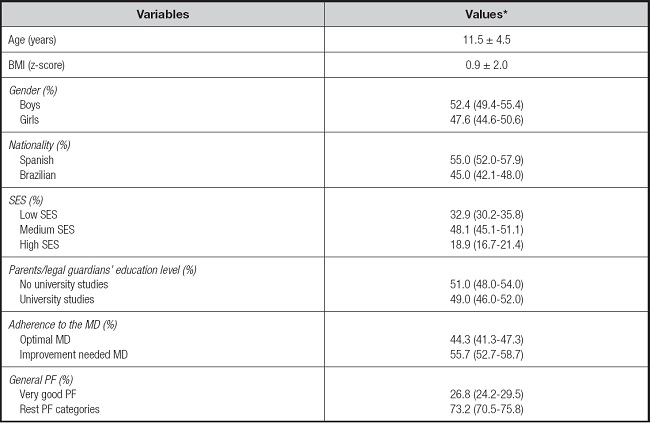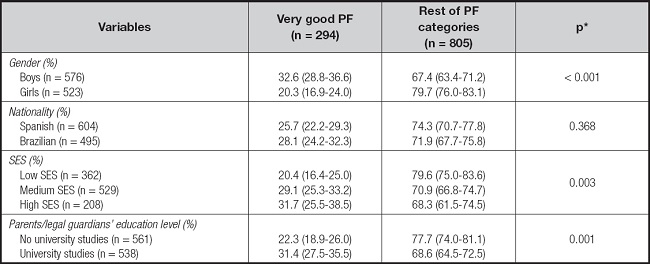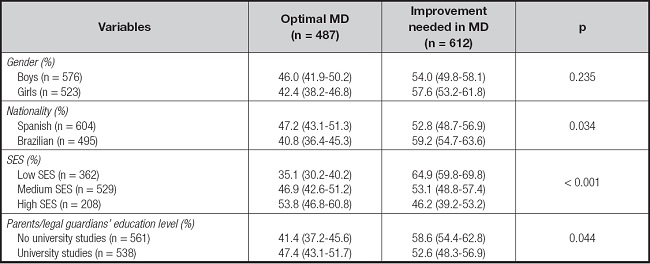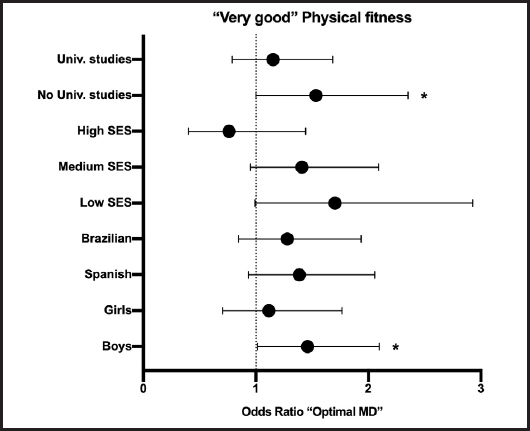INTRODUCTION
Physical fitness (PF) is considered a powerful marker of health for children and adolescents due to its benefits for several health outcomes (1). The scientific literature suggests that cardiorespiratory fitness (2), and muscular fitness (3) are the main indicators of health in children and youth. Besides the benefits that PF provides to children and adolescents during their development, the scientific literature has reported a prospective negative association between muscular fitness and adiposity and cardiometabolic parameters in later life (4). Also, strong evidence supports that higher levels of cardiorespiratory fitness during the childhood and adolescence are associated with a healthier cardiovascular profile later in life (5).
The relationship between PF and adherence to the Mediterranean diet (MD) has been previously studied and a recent meta-analysis has concluded that an improvement of dietary habits towards those proposed by MD is associated with higher PF in children and adolescents (6). Although the relevance of adhering to MD over PF in children has been suggested (7), it seems that MD does not overcome the effect that fitness could have in the relationship with cardiovascular risk, as it was found in a study with 2477 adolescents (8).
The pandemic caused by COVID-19 has impacted negatively in children and adolescents' movement behaviors (9); it is well known that a reduction in physical activity and an increase in sedentary behavior have negative effects on PF (10). Regarding the dietary habits, the population in general reported an increase in the number of snacks consumed and also an increase in meal numbers and frequency; however studies reporting these dietary habits in younger population are scarce (11).
These indicators, associated with obesity and metabolic health, are elevated in people with low socioeconomic status and in some ethnicities, therefore it is suggested that solutions should be provided to facilitate this situation (12). In addition, it is recognized that social determinants of health have presented an even bigger effect during the COVID-19 pandemic (13), hence it is necessary to provide new insights on the role of these determinants in relation with PF and MD. Given that a reduction of PF during the COVID-19 pandemic has been estimated (14), there is a lack of information about its association with MD and the role of social determinants on this relationship. Thus, the aim of this study was to assess the association between adherence to MD and proxy-reported general PF among Spanish and Brazilian children and adolescents during the COVID-19 lockdown, according to several inequality indicators (gender, nationality, socioeconomic status, and parents/guardians' education level).
METHODS
STUDY DESIGN AND PARTICIPANTS
Parents and guardians of children and adolescents aged between 3 and 17 years old were contacted through different dissemination ways to be enrolled in an online survey. The online survey was administrated during 15 days in Spain and Brazil (between March and April 2020). It required 15 minutes to be completed and contained an informed consent at the beginning. They were asked to complete the survey in case they had been at home with restrictions of going out during the previous week. In total, 1263 participants completed the online survey, but 164 were removed for different reasons (outside the age range or missing values). The STROBE statement for nutritional epidemiology was used for reporting this study supplementary table I.
ETHICS
This study was conducted according to the guidelines laid down in the Declaration of Helsinki and all procedures involving human subjects were approved by the Ethical Committee of the Catholic University of Murcia in Spain (Registration: CE112001) and the Technical University of Paraná in Brazil (Registration: 4.275.232). Written informed consent was obtained from all participants.
SOCIODEMOGRAPHIC INFORMATION
General sociodemographic information from the parents/guardians was requested in the first part of the online survey, including information about nationality, socioeconomic status (SES) (assessed by the Family Affluence Scale III) (15), parents/guardians' education level, and children and adolescents' age and gender.
ANTHROPOMETRIC PARAMETERS
Weight and height were proxy-reported by parent/guardians about their children. Body mass index (BMI) was calculated following standard procedures and then BMI (z-score) was computed (16).
PROXY-REPORTED PHYSICAL FITNESS
The International Fitness Scale (IFIS) was used to assess proxy-reported PF (17). This scale is a short, self-administered scale that assess PF. The IFIS is composed of five Likert-scale questions asking the perceived overall fitness, cardiorespiratory, muscular fitness, speed-agility, and flexibility in comparison with their friends. For the current study, only the overall fitness item was selected.
Even though the Likert-scale is composed of five categories ("very poor", "poor", "average", "good" and "very good"), the results of the current study were collapsed into two new categories as follows: "very good" PF category and the other PF categories ("very poor"; "poor"; "average" and "good"). This categorization was done to increase the statistical power and to focus the analysis on the "very good" category.
ADHERENCE TO THE MEDITERRANEAN DIET
To assess adherence to MD the Mediterranean Diet Quality Index in Children and Adolescents was used (18). It was completed by the participants' parents/guardians, and it is composed by 16 dichotomic questions, 12 of them about positive aspects and 4 of them about negative aspects related to MD. Answering in the affirmative to positive questions adds 1 point, while answering in the affirmative to negative questions detracts 1 point. Negative answers to all the questions are coded as zero. The total score of the Mediterranean Diet Quality Index in Children and Adolescents index ranges from 0 to 12 points.
The results were organized in three categories: "Optimal MD" (> 8 points); "improvement needed to adjust intake to Mediterranean patterns" (4-7 points); and "very low diet quality" (< 4 points). The last two categories were collapsed into one category, which was defined as "improvement needed to MD". This categorization was done to increase the statistical power and focusing the analysis on the "optimal MD" category.
STATISTICAL ANALYSIS
The Statistical Package for Social Sciences v.25 (SPSS, IBM Corp., Armonk, NY, USA) was used to perform all the analyses. Data were expressed as mean (standard deviation) for continuous variables, while categorical variables were expressed as absolute frequency (percentage).
The Chi-squared test was used to test the association of different categorized variables of inequality with exposure and outcome.
To determine the odds ratio of proxy-reported "very good" PF in relation to adherence to MD, a binary logistic regression was performed stratifying the sample according to inequality variables (gender, nationality, SES, and parents/guardians' education level). Interaction between inequality indicators (nationality, SES, and parents/guardians´ education level), proxy-related PF and adherence to the MD were tested. A p value ≤ 0.05 was set for statistical significance.
RESULTS
The interaction between inequality variables in the association between proxy-reported PF and adherence to MD was reported with a statistically significant interaction in nationality, SES, and education level (p < 0.05 for all), while no statistically significant interaction was found for gender (p > 0.05).
Descriptive characteristics of the sample are presented in table I. Of the total sample of participants, 1099 in total, a higher percentage were boys (52.4 %), Spanish (55.0 %), medium SES (48.1 %), and with parents/legal guardians without university studies (51.0 %). Most of the sample need improving MD adherence (55.7 %) and only 26.8 % of participants reported "very good" PF.
Table I. Descriptive characteristics of participants (n = 1099).

BMI: body mass index; MD: Mediterranean diet; PF: physical fitness; SES: socioeconomic status.
*Age and BMI are presented as mean (standard deviation). Categorical variables are presented as percentage (95 % confident interval).
The proxy-reported general PF stratified by inequality indicators is presented in table II. A lower proportion of participants reported "very good" PF. Most of the participants reporting "very good" PF in each inequality indicator were boys (32.6 % vs 20.3 % of girls; p < 0.001), participants from Brazil (28.1 % vs 25.7 % from Spain; p > 0.05), also more classified in the high SES level (31.7 % vs 29.1 and 20.4 % in medium and low SES, respectively; p < 0.05), or with parents/legal guardians' education level with university studies (31.4 % vs 22.3 % without university studies; p = 0.001).
Table II. Proxy-reported general physical fitness according to inequality indicators (n = 1099).

PF: physical fitness;
SES: socioeconomic status.
*Statistical significance at p < 0.05.
Values are presented as percentage (95 % confidence interval).
The adherence to MD stratified by inequality indicators is presented in table III. A lower proportion of participants reported an "optimal" MD. Most of the participants reporting "optimal" MD were boys (46.0 % vs 42.4 % of girls; p > 0.05), participants from Spain (47.2 % vs 40.8 % from Brazil; p < 0.001), classified as high SES level (53.8 % vs 46.9 and 35.1 % of medium and low SES, respectively; p < 0.05), and with parents/legal guardians with university studies (47.4 % vs 41.4 % without university studies; p < 0.05).
Table III. Adherence to Mediterranean diet according to inequality indicators (n = 1099).

MD: Mediterranean diet; SES: socioeconomic status.
*Statistical significance at p < 0.05.
Values are presented as percentage (95 % confidence interval).
Figure 1 and supplementary table II shows the odds ratio of reporting "very good" PF in accordance with the reporting an "optimal MD" level of adherence to the MD. Each part of the figure shows comparisons by the social determinants described previously (gender, nationality, SES, and parents/guardians' education level). A higher odd of presenting a "very good" PF was found in both boys and girls with "optimal" adherence to the MD (OR = 1.5; 95 % CI: 1.0-2.1; p < 0.05 vs OR = 1.1; 95 % CI: 0.7-1.8; p > 0.05) in comparison with the reference category, but only in boys the association was statistically significant. Both nationalities (Spanish and Brazilian) presented higher odds of reporting "very good" PF when also reporting "optimal" MD (OR = 1.4; 95 % CI: 0.9-2.1 and OR = 1.3; 95 % CI: 0.8-1.9, respectively), but the odds were not statistically significant. Regarding the SES, when participants were classified in the low and medium SES level, they presented higher odds of reporting a "very good" PF with an "optimal" MD (OR = 1.7; 95 % CI: 0.9-2.9 and OR = 1.4; 95 % CI: 0.9-2.1, respectively), but not for participants classified in the "high SES" level (OR = 0.8; 95 % CI: 0.4-1.4); however, the odds were not statistically significant. Finally, participants with parents/legal guardians' education level without university studies presented statistically significant odds of reporting "very good" PF with an "optimal" MD (OR = 1.5; 95 % CI: 1.0-2.4; p = 0.05) in comparison with those with university studies (OR = 1.2; 95 % CI: 0.8-1.7; p > 0.05).
DISCUSSION
The aim of the current study was to analyze the association between adherence to MD and proxy-reported general PF in a sample of children and adolescents from Spain and Brazil during the COVID-19 lockdown according to gender, nationality, SES, and parents/guardians' education level. The main results show that boys reporting "optimal" MD are more likely to report "very good" PF when compared to girls. In addition, those participants whose parents/legal guardians reported no university studies were more likely to report "very good" PF when reporting "optimal" MD in comparison with the university studies category. Regarding the rest of inequalities analyzed, although nationality and/or SES were associated to proxy-reported PF and adherence to MD, no statistically significant odds ratio of reporting "very good" PF was observed when participants reported "optimal" MD.
Overall, previous evidence has observed a positive relationship between MD and cardiorespiratory/muscular fitness, and a negative relationship with speed-agility, suggesting that an improvement of the MD pattern could be associated with higher PF in the youth (6). A study with results based on PF field test with data before the COVID-19 pandemic also observed the association between adherence to MD and PF level (19). In this sense, the relationship between physical activity and MD (6,20) is well known, as well as between physical activity and PF in children (21). Therefore, those participants with higher standards of lifestyle (physical activity and high adherence to MD) could be more likely to score higher in PF test (reported or field-based).
GENDER
The current study shows differences between boys and girls regarding proxy-reported PF and adherence to MD. Boys are represented in a higher proportion in the "very good" level of PF and in the "optimal" level of adherence to MD when compared with girls. Also, males who have a "very good" level of PF are more likely to have good MD. However, this association was not present in females. In this line, gender disparities in PF have been extensively informed by the scientific literature. A recent observational study (22) reported that boys presented higher odds to meet aerobic capacity fitness standards than girls in a sample of 15,052 children (average age, 10.7 years). Although the differences observed in the current study were obtained using proxy-reported data collected during the COVID-19 lockdown, results are consistent with the previous knowledge.
Also, it is important to highlight that a higher proportion of boys reported "very good" PF in comparison with girls (p < 0.001), while no differences between the proportion of boys and girls that reported "optimal MD" was observed (p = 0.235). A previous study suggests that an optimal adherence to MD is not enough to reduce cardiometabolic risk and it might be combined with higher levels of PF (8). Therefore, even though the proportion of girls with "optimal MD" in the current study is similar to the proportion of boys, this proportion of girls might not be sufficiently protected against cardiometabolic risk due to the level of PF reported.
NATIONALITY
Similar proportions of participants from both countries reported "very good" PF, while a higher proportion of Spanish participants reported "optimal MD" in comparison with their Brazilian counterparts. In line with this, the analysis of MD in Brazil is scarce yet, and the translation and cultural adaptation of the tool used in the current study is recent (23). Generally, Spain is one of the European countries reporting the lowest adherence to MD in both children and adolescents (20); however, the current study report almost half of Spanish participants with an "optimal" level of adherence to MD. Brazil is located in a different latitude and altitude, and their dietary patterns could differ from those related to MD in accordance with previous knowledge (24). Then, mixing these two countries in this study might have led to controversial results respect those expected for Mediterranean and not Mediterranean countries (25).
SOCIOECONOMIC STATUS AND PARENTAL EDUCATION LEVEL
The lower odds of reporting "very good" PF by reporting "optimal MD", the higher SES has been observed among the participants in the current study. However, participants with higher SES represent a higher proportion reporting "very good" PF (p = 0.003) and "optimal MD" (p < 0.001) with respect to the other two SES. These two facts are in accordance with previous studies reporting a lower performance in PF tests in children with lower SES (26) and also higher SES associated with higher adherence to MD (27). Also, due to the well-known relationship between SES and education level, it was expected to find similar results regarding parental education level. Hence, those participants with parents/legal guardians holding "university studies" reported a higher statistically significant proportion of participants with "very good" PF (p = 0.001) and a higher statistically significant proportion of participants with "optimal MD" (p = 0.044). However, participants with parents/legal guardians with "no university studies" had higher odds of "very good" PF when they reported "optimal MD" (OR = 1.5; 95 % CI, 1.0-2.4, p = 0.05) in comparison with the odds observed in the category "university studies" (OR = 1.2; 95 % CI, 0.8-1.7, p = 0.464). It is well-known the role of the mothers' education level in relationship with children and adolescents' dietary habits (27), and this fact could have influenced the observed results, but the current study did not register which of the parents completed the survey, therefore these results must be interpreted with caution. In addition, parental educational level mediates the association between adherence to MD and obesity (28), therefore this social factor must be considered in these relationships.
STRENGTHS AND LIMITATIONS
The current study presents the strength of analyzing the association during the COVID-19 lockdown, when social inequalities have been shown as strong factors affecting differences between people. Also, it is relevant to highlight that this study used a questionnaire to report PF and results are in accordance with a previous study using field tests (22), which could be relevant to test larger sample size since the use of questionnaires requires less time in comparison with field tests.
Also, there are limitations to be recognized. This is a cross-sectional study; therefore, conclusions should be interpreted with caution. Also, each country adopted different restrictions that could have affected in different ways to the workers in each SES. Besides, due to the impossibility to assess PF using field test, the current study used a proxy-reported PF questionnaire, which has limitations to report the real PF status. In addition, we recorded only the education level of the person that completed the survey when it has been observed that mother's education is a determinant of the MD (20).
CONCLUSIONS
There was more likely to report a "very good" PF during the COVID-19 lockdown when the participant was classified as "optimal MD" in boys in comparison with the odds observed in girls. In addition, an association between "very good" PF and "optimal MD" was observed in participants with parents/legal guardians with "no university studies".
These results must be considered with caution because there is controversy with the scientific literature before the COVID-19 pandemic; however, the new situation observed during the lockdown could have affected these relationships.















